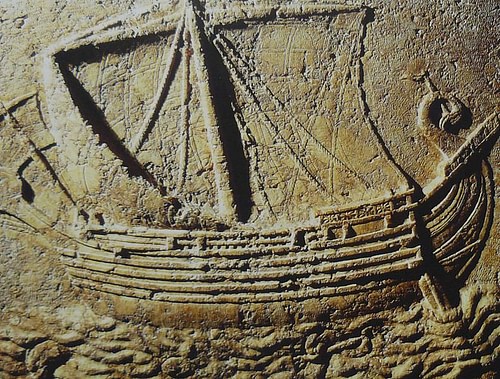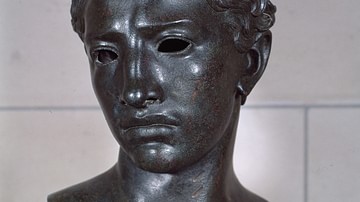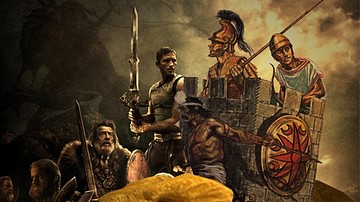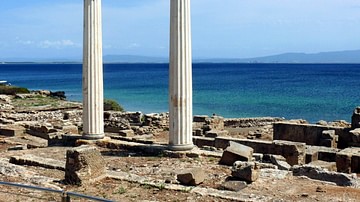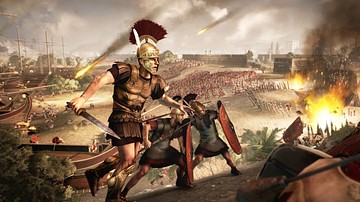In the 5th century BCE, the Carthaginian explorer Hanno sailed beyond the Pillars of Hercules, out of the Mediterranean and into hitherto unknown territory down the Atlantic coast of Africa. In his search to find new resources and trading opportunities he encountered such exotic and unfamiliar sights as restless natives, swift-footed pygmies, gorillas, and erupting volcanoes. The expedition became, even in antiquity, one of the most celebrated voyages of discovery ever undertaken.
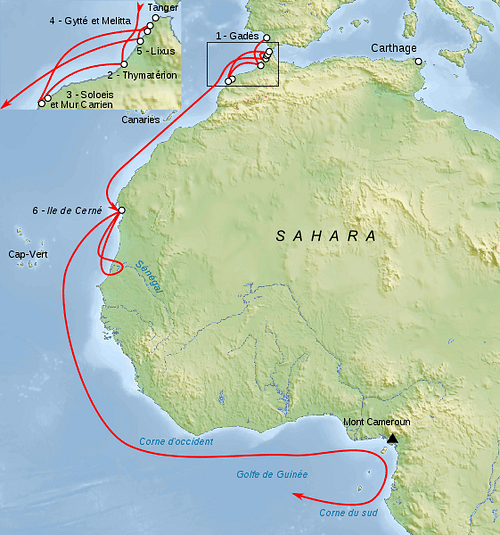
Sources
The first-hand account of Hanno's voyage survived through antiquity and into the modern age via a single medieval manuscript, itself a copy of a Greek translation made from the Punic original which was carved on a dedicatory stele c. 400 BCE. Scholars consider there to be at least two missing parts of the surviving text, including the conclusion. The work, titled simply The Periplus (Coastal Voyage), is short, but such is the paucity of Punic literature which survives it is invaluable far beyond its subject matter of seafaring and exploration. The original surviving manuscript is part of the Codex Palatines Graecus 398 and resides in the University of Heidelberg library.
Hanno
Hanno is referred to in the text by the Greek term basileus which is almost certainly a translation of the Punic suffete, the highest administrative role in the Carthaginian government, often translated as 'magistrate'. His name is a common one in the powerful Carthaginian clan the Magonids and would suggest he was a member of it. Beyond this, we have no other information about the leader of the expedition. The Roman historian Justin mentions in passing a Hanno who fought a war with Mauritanian natives in the mid-5th century BCE. Given that Hanno's expedition established colonies in this area (Morocco) and would probably have caused competition with local tribes, this may well be the same person. Other ancient sources which refer to the expedition include Herodotus in the 5th century BCE, Palaephatus in the 4th century BCE, the Aristotelian Mirabilium auscultationes, and various later Roman writers such as Pliny the Elder and Arian who likely consulted a 1st-century CE work by Juba II of Mauretania titled The Wanderings of Hanno.
The precise date of the voyage is not stated but was probably undertaken sometime between the late 6th century BCE and c. 425 BCE. The Carthaginian ships were made from wood and had a single sail with the possibility of oar power if necessary. They did not have the compass and so relied on the stars, especially Ursa Minor, for navigation. These considerations lead some scholars to argue a particular final destination for the expedition based on the time available, as we shall see later.
Below is Hanno's text in full (modern names, where identifiable, are added in parentheses by this author):
This is the story of the long voyage of Hanno king of the Carthaginians into Libyan lands beyond the Pillars of Heracles [Straits of Gibraltar], which he dedicated on a tablet in the temple of Kronos [Baal Hammon]:
I The Carthaginians decided that Hanno should sail beyond the Pillars of Heracles and found cities of Libyphoenicians [Carthaginians]. He set sail with sixty penteconters and about thirty thousand men and women, and provisions and other necessaries.
II After sailing beyond the Pillars for two days we founded the first city which we called Thymiaterion [Tangier]. Below it was a large plain.
III Sailing thence westward we came to Soloeis, a Libyan promontory covered with trees. There we founded a temple to Poseidon.
IV Journeying eastward for half a day we reached a lake not far from the sea, covered with a great growth of tall reeds, where elephants and many other wild animals fed.
V A day's journey beyond this lake we founded cities on the coast called Karikon Teichos, Gytte, Akra, Melitta, and Arambys.
VI Passing on from there we came to the large river Lixos [the Draa in Morocco], flowing from Libya, beside which nomads called Lixitae [Berbers] pastured their flocks. We stayed some time with them and became friends.
VII Inland from there dwelt inhospitable Ethiopians [negroes] in a land ridden with wild beasts and hemmed in by great mountains. They say that Lixos flows down from there and that among these mountains Troglodytes of strange appearance dwell, who according to the Lixitae can run more swiftly than horses.
VIII Taking interpreters from the Lixitae we sailed south along the desert [Sahara] shore for two days and then for one day eastward and found a small island five stades [c. 1 km] in circumference at the farther end of a gulf. We made a settlement there and called it Cerne. We judged from our journey that it was directly opposite Carthage, for the voyage from Carthage to the Pillars and from there to Cerne seemed alike.
IX From here sailing up a big river called Chretes [Senegal] we reached a lake, in which were three islands bigger than Cerne. Completing a day's sail from here we came to the end of the lake, overhung by some very high mountains crowded with savages clad in skins of wild beasts, who stoned us and beat us off and prevented us from disembarking.
X Sailing from there we came to another big wide river, teeming with crocodiles and hippopotamuses. We turned again from there and came back to Cerne.
XI We sailed south for twelve days from there, clinging to the coast, which was all along occupied by Ethiopians who did not stay their ground, but fled from us. Their speech was unintelligible, even to our Lixitae.
XII On the last day we came to anchor by some high mountains clad with trees whose wood was sweet-smelling and mottled.
XIII Sailing round these for two days we reached an immense gulf, on either shore of which was a plain where by night we saw big and little fires flaming up at intervals everywhere [Grass fires?].
XIV Taking on water here, we sailed on for five days along the coast until we came to a great bay which our interpreters called the Horn of the West. In it was a large island and in the island a salt-water lake, within which was another island where we disembarked. By day we could see nothing but a forest, but by night we saw many fires burning and we heard the sound of flutes and of beating of cymbals and drums and a great din of voices. Fear came upon us and the soothsayers bade us leave the island.
XV We sailed thence in haste and skirted a fiery coast replete with burning incense. Great streams of fire and lava poured down into the sea and the land was unapproachable because of the heat.
XVI We left there hurriedly in fear and sailing for four days we saw the land by night full of flames. In the middle was a high flame taller than the rest, reaching, as it seemed, the stars. By day it was seen to be a very high mountain called the Chariot of the Gods [Mt. Cameroon?].
XVII Thence sailing for three days past fiery lava flows we reached a gulf called the Horn of the South.
XVIII At the farther end of this bay was an island, like the first, with a lake, within which was another island full, of savages. By far the greater number were women with shaggy bodies, whom our interpreters called Gorillas [Pygmies?]. Chasing them we were unable to catch any of the men, all of whom, being used to climbing precipices, got away, defending themselves by throwing stones. But we caught three women, who bit and mangled those who carried them off, being unwilling to follow them. We killed them, however, and flayed them and brought their skins back to Carthage. For we did not sail farther as our supplies gave out. (Quoted in Moscati, 182-3)
Assessment
The Greek translation of Hanno's text has taken some liberties with names, and there are geographical inaccuracies. The historian S. Moscati plausibly suggests that these may have been deliberately included to prevent unwanted competitors muscling in on Carthaginian trade relations. The final part of the journey is debated amongst historians. Some suggest Hanno reached only Sierra Leone, others that he went as far south as the Cameroons or Gabon. Even the shorter journey, which some prefer because Hanno would have struggled in the time to reach further south, would still have involved an outbound leg of almost 5,000 kilometres (3,000 miles).

The fact that Carthaginians sailed down the west coast of Africa is corroborated by Herodotus (who could, of course, have merely been paraphrasing the Periplus) in Book IV:196 of his Histories and by the fact that the whole expedition was to found colonies, strongly suggesting that the Carthaginians had visited the coast previously in order to ascertain it was worthwhile sending Hanno's large fleet. Pliny the Elder mentions that the voyage began from Gades (Cadiz) and that, on returning, the 'gorilla' skins were kept in the temple of Juno (Tanit or Astarte) at Carthage. The 'gorillas' of the text is actually the most significant legacy of the voyage as that term, of uncertain significance in the Hanno text but probably not referring to animals (chimpanzees being often suggested), was applied by Thomas Savage, a naturalist of the 19th century CE, to the now familiar large African apes.
Other Carthaginian travellers soon followed and exploited the newfound sources of gold, the bartering for which is described by Herodotus. Then another famous traveller, the Greek Polybius, followed in the wake of Hanno and sailed down the same Atlantic coastline in the 2nd century BCE. For whatever reason, though, significant further exploration of the African coast and interior would have to wait another 1,000 years.
